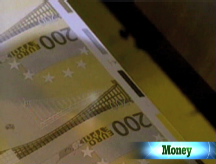Dollar hits 5-month high
Signs of weakness in the European economy put the U.S. currency in a more favorable light.
NEW YORK (CNNMoney.com) -- The dollar surged to a five-month high against the euro Friday after European economic reports compounded worries that the 15-nation euro economy is in a tailspin.
The euro lost more than three cents on the dollar, falling to $1.5008 in New York trading from $1.5328 late Thursday, a level not seen since Feb. 27, when the euro hit a trading low of $1.4917, according to DailyFX.com.
The dollar also gained against the Japanese yen, rising to ¥110.25 from ¥109.45 Thursday, after a survey showed that sentiment in the Japanese services sector in July had fallen for the fourth straight month.
"The dollar is strengthening on the perceived potential weakness in the rest of the globe," said Dustin Reid, senior currency strategist with ABN Amro.
Euro economy: The gross domestic product of Italy, the euro zone's third-largest economy, fell 0.3% in the second quarter, according to a report from the Italian statistics office. Economists had expected Italy's economy to remain flat.
A separate report released by the European Central Bank showed that European banks continued to tighten their lending standards through the second quarter as they expected economic declines in the region.
Also adding to European worries, ECB council member Nout Wellink said in an interview with Dutch television network RTL that euro inflation could rise above 4%.
A day earlier, the dollar jumped as the ECB held a key interest rate steady in order to keep cash flowing into the economy. The ECB had previously been raising rates in an attempt to ward off inflation.
After the ECB announcement Thursday, bank President Jean-Claude Trichet said the decision to keep rates at 4.25% came as inflation remained a concern, though the European economic growth outlook was gloomy.
"Trichet typically does not talk like that," said Reid.
Fed rate hikes? Unlike its European counterpart, the U.S. Federal Reserve had made a habit of cutting rates to inject liquidity into the financial markets. But as inflation became more of a concern, it began keeping rates steady.
There have even been worries among members of the Fed's Open Market Committee, which votes on monetary policy, that inflation has become of greater concern than keeping cash available to banks.
Investors have seized on this concern, as weakness in international markets could support the dollar enough to make rate hikes possible.
"Everything is in favor of the greenback," said Antonio Sousa, chief strategist at DailyFX.com. "The market is pricing in three rate hikes over the next eight Fed decisions [12 months]."
Undue optimism: Worries about Europe's economy have been on the radar screen, but they had been largely overlooked as the market focused on the U.S. economy these past few months.
"Europeans have been much more optimistic of their assessments than they should've been," said Robert Brusca, economist with FAO Economics.
That optimism allowed Europe's economic problems to accumulate, according to Brusca.
The British pound also lost ground, falling to a 17-month low of $1.9164 after a report from the U.K.'s Council of Mortgage Lenders showed home repossessions had reached the highest level in 12 years through the first half of 2008.
U.S. economy: Consumer confidence in the U.S. economy gained somewhat through the last part of July, according to a report from Discover Financial Services, lending some domestic backing to the dollar's rise.
The survey of the spending habits of 15,000 Americans ticked up only slightly in July, as consumers were weighed down by high gasoline prices, but Discover noted a significant rise in confidence over the final week of the month.
It was only through the last half of July that crude oil prices had begun to trend downward.
Commodities: Crude oil prices have fallen more than $32 a barrel since hitting a record high in July, as investors worried about falling demand due to high energy costs. Gas prices have followed suit, falling for 22 straight days.
The rallying dollar egged on those declines Friday, helping to drive oil down more than $4 a barrel, as investors pumped investment money back into the dollar and concerns about supply disruptions from Turkey eased.
Commodities, particularly oil futures, are often purchased to hedge against inflation. ![]()



